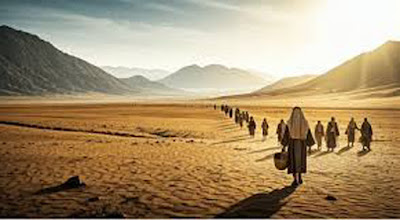Parashat
Bamidbar
How Does
the Wilderness Prepare Us to Inherit the Land of Israel?
What
made Me Embrace the Torah in The Old City of Jerusalem on Shavuot?
This
Shavuot, I celebrate 45 years of Torah! I can hardly believe how the years have
flowed by, like foamy waves softening and refining our hearts, as hardships
etched their traces into the furrows of our faces. I look back with nostalgia
to that first Shavuot – the beginning of my teshuva – when everything was new.
I found myself among a circle of women, sitting on cool stones under the starry
sky in the Old City of Jerusalem. It was the first time I learned about Ruth –
who left behind the comfort of her regal home, her country, and all that was
familiar, to follow her aged mother-in-law Naomi toward an unknown destiny.
I, too,
had recently left my own country, my childhood home, and the prospect of a
prestigious university degree to follow my heart and fulfill an undefined
calling. Was Ruth also a truth seeker, who found the pomp of prosperity
superficial while looking for a deeper meaning and mission in life? I pondered.
Since my
teenage years, I had been searching for truth. I had rejected the Marxism I was
taught in high school, which focused solely on dismantling economic classes without
addressing the values that would define the envisioned society of financial
equality. Dancing in the inner city with born-again Xtians whose theology
conflicted with everything I would later come to value felt exciting at the
time, but their answers rang hollow and rehearsed. Though I was a flower-power
girl immersed in the hippy counterculture, I was never drawn enough to the East
to join my friends traveling to India and Nepal in search of spirituality and
inner vision. Yoga helped me strengthen my body, but it in no way touched my
soul.
I had
never considered seeking truth within my own Jewish heritage. The Jewish
experiences of my youth had led me to believe Judaism was nothing more than a
culinary creed wrapped in outdated rules, lacking any spiritual essence.
Yet here
I was, in the holy city of Jerusalem, at the Women’s Division of the Diaspora
Yeshiva – where I had surprisingly found my spiritual home. I still remember
hearing Rabbi Goldstein proclaim: “Now that you’ve received the Torah, can you
give it back? No, you can’t. You have to keep it!” At that moment, I knew I was
hooked for life.
What
Does it Take to Make our Torah Transformative and Enduring?
The Imrei
Emet explains that the Torah was given to rectify the three core flaws of
humanity – jealousy, lust, and pride – reflected in the sins of early
generations: Kayin, the generation of the Flood, and the Tower of Babel. The
mitzvot at Matan Torah correspond to these: the boundary around Mount Sinai
addressed jealousy – giving each person their designated space; the command to
abstain from marital intimacy represented restraint – countering lust; and
standing humbly at the foot of the mountain symbolized submission – opposing
pride. This is why the Torah was given with fire, water, and wilderness –
representing passion, humility, and self-nullification. Every day, we are
challenged by jealousy, lust, and pride – and only through the power of Torah
can we overcome them. Moreover, to truly acquire Torah, we must make ourselves
like a wilderness – open, humble, and ownerless (Imrei Emet, Bamidbar, 5667).
This concept hits home when I reminisce about those early days of embracing
Torah, most of the students in Diaspora Yeshiva from affluent American families,
made great sacrifices to leave flourishing careers and promising prosperous
futures behind, to dedicate ourselves to Torah learning in the Land of Israel. As
the Imrei Emet teaches, as long as we make ourselves like a desert completely
given over and devoted to Torah and Mitzvot (mesirut nefesh), through
this inner work of surrendering our selves, our Torah becomes transformative
and enduring. Now, 45 years later this concept has proven true through the
descendants of the students of the ‘hippy yeshiva’ raising families deeply
rooted in Torah and mitzvot.
Thus, the desert became a place of alignment – each soul drawn to its specific inheritance, in sync with its Divine source. This is hinted in the verse: וְאִישׁ עַל־דִּגְלוֹ בְאֹתֹת לְבֵית אֲבֹתָם יַחֲנוּ “Each man by his banner, according to the signs of their father’s house shall they camp” (Bamidbar 2:2). The אֹתֹת/otot – “signs” – may be understood as spiritual markers, revealing each tribe’s unique role within the collective mission of Am Yisrael in Eretz Yisrael.
May we each walk our personal midbar with courage and faith – shedding old identities, listening to the voice of Hashem, and preparing our hearts to receive our portion in the Holy Land. And may we soon see the full inheritance of Am Yisrael revealed – each tribe, each soul, restored to its rightful place in the Land.









